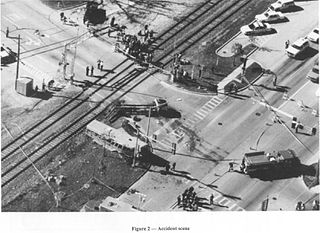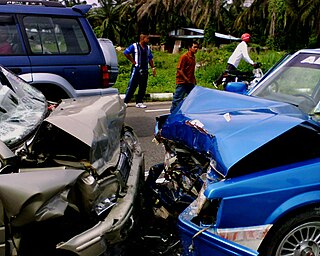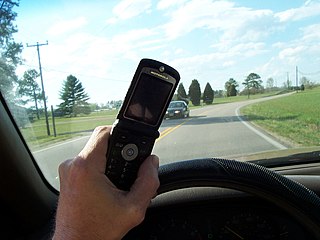
A seat belt is a vehicle safety device designed to secure the driver or a passenger of a vehicle against harmful movement that may result during a collision or a sudden stop. A seat belt reduces the likelihood of death or serious injury in a traffic collision by reducing the force of secondary impacts with interior strike hazards, by keeping occupants positioned correctly for maximum effectiveness of the airbag and by preventing occupants being ejected from the vehicle in a crash or if the vehicle rolls over.

Automotive safety is the study and practice of design, construction, equipment and regulation to minimize the occurrence and consequences of traffic collisions involving motor vehicles. Road traffic safety more broadly includes roadway design.
The Texas A&M Transportation Institute (TTI) in College Station, Texas is the largest transportation research agency in the United States. Created in 1950, primarily in response to the needs of the Texas Highway Department, TTI has since broadened its focus to address all modes of transportation–highway, air, water, rail, pipeline, and automated/connected vehicles. TTI is a state agency and a member of the Texas A&M University System. TTI’s cooperative relationship with the Texas Department of Transportation has helped the Institute develop and implement work for numerous other sponsors.

The standard Safe Practices for Motor Vehicle Operations, ANSI/ASSE Z15.1, defines defensive driving skills as "driving to save lives, time, and money, in spite of the conditions around you and the actions of others." This definition is taken from the National Safety Council's Defensive Driving Course. It is a form of training for motor vehicle drivers that goes beyond mastery of the rules of the road and the basic mechanics of driving. Its aim is to reduce the risk of collision by anticipating dangerous situations, despite adverse conditions or the mistakes of others. This can be achieved through adherence to a variety of general guidelines, such as following the assured clear distance ahead and two second rules, as well as the practice of specific driving techniques. Some motorists describe defensive driving as "driving as if everyone else on the road were drunk."

Advanced driver-assistance systems (ADAS), are electronic systems that helps the vehicle driver while driving or during parking. When designed with a safe human-machine interface, they are intended to increase car safety and more generally road safety.
Life Teen is a Catholic youth ministry organization and movement originating in the United States. Life Teen believes that "Eucharist-based ministry has the power to transform teens, transform parishes, and transform culture." "Inspired by pope John Paul II's call for a New Evangelization, Life Teen believes that youth are the key to this new springtime in the Church."

The 1995 Fox River Grove bus–train collision was a grade crossing collision that killed seven students riding aboard a school bus in Fox River Grove, Illinois, on the morning of October 25, 1995. The school bus, driven by a substitute driver, was stopped at a traffic light with the rearmost portion extending onto a portion of the railroad tracks when it was struck by a Metra Union Pacific / Northwest Line train en route to Chicago.
Trinity Industries Inc. is an American industrial corporation that owns a variety of businesses which provide products and services to the industrial, energy, transportation and construction sectors.

Substance Abuse Prevention, also known as drug abuse prevention, is a process that attempts to prevent the onset of substance use or limit the development of problems associated with using psychoactive's substances. Prevention efforts may focus on the individual or their surroundings. A concept known as "environmental prevention" focuses on changing community conditions or policies so that the availability of substances is reduced as well as the demand.

Mika Mäki is a Finnish former racing driver.

A collision avoidance system, also known as a precrash system, forward collision warning system, or collision mitigation system, is an automobile safety system designed to prevent or reduce the severity of a collision. It uses radar (all-weather) and sometimes laser (LIDAR) and camera to detect an imminent crash. GPS sensors can detect fixed dangers such as approaching stop signs through a location database.

A traffic collision, also called a motor vehicle collision (MVC) among other terms, occurs when a vehicle collides with another vehicle, pedestrian, animal, road debris, or other stationary obstruction, such as a tree, pole or building. Traffic collisions often result in injury, death, and property damage.

Texting while driving, also called texting and driving, is the act of composing, sending, reading text messages, email, or making similar use of the web on a mobile phone while operating a motor vehicle. Texting while driving is considered extremely dangerous by many people, including authorities, and in some places have either been outlawed or restricted. As a form of distracted driving, texting while driving significantly increases the chances that a driver will be involved in a motor vehicle accident.
Sex education in the United States is taught in two main forms: comprehensive sex education and abstinence-only. Comprehensive sex education is also called abstinence-based, abstinence-plus, abstinence-plus-risk-reduction, and sexual risk reduction sex education. This approach covers abstinence as a choice option, but also informs adolescents about human sexuality, age of consent and the availability of contraception and techniques to avoid contraction of sexually transmitted infections.
Tire Rack Street Survival is a teen driving program governed by the BMW CCA Foundation. Through the volunteer efforts of members of the BMW Car Club of America, the Sports Car Club of America, the Mercedes-Benz Club of America the Porsche Club of America and the Audi Club of North America as well as other automotive enthusiasts who serve as the personal coach with each teen, over 100 schools will be held across the U.S. this year.

A five-point harness is a form of seat belt that contains five straps that are mounted to the car frame. It has been engineered for an increase of safety in the occurrence of an automobile accident. As a result, this form of seat belt has been mandated in the race car competition of NASCAR. This was an invention made mandatory to have due to the high velocities involved in the sport. Along with the design of the seat belt, helmet straps have been designed to increase the safety of the driver. This invention has also been used to secure infants and young children in child safety seats.
National Teen Driver Safety Week (NTDSW) is conducted annually during the third week of October in the United States. It was established by Congress in 2007.
The Teen Driver Challenge (TDC) sponsored by the Florida Sheriffs Association (FSA) is a 12-hour course presented to students over a two-day period, ideally with a 5-to-1 student-to-instructor ratio. The course will provide students with the knowledge and hands-on experience to reduce their chances of being involved in a crash. Attendance and participation in this training will provide students with life saving skills, techniques and education about the operation of a motor vehicle. The hours spent participating in the Teen Driver Challenge can be used toward fulfilling the requirements set forth in Florida's Graduated Driver's License program.

Teenage pregnancy in the United States relates to girls under the age of 20 who become pregnant. 89% of these births take place out-of-wedlock. In the 2010s, teen pregnancy has declined almost continuously.
The flail space model (FSM) is a model of how a car passenger moves in a vehicle that collides with a roadside feature such as a guardrail or a crash cushion. Its principal purpose is to assess the potential risk of harm to the hypothetical occupant as he or she impacts the interior of the passenger compartment and, ultimately, the efficacy of an experimental roadside feature undergoing full-scale vehicle crash testing.












